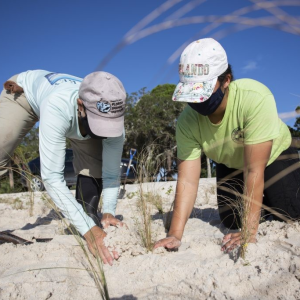Florida’s coastlines are famous for their stunning beaches and vibrant ecosystems but also for the formidable hurricanes that often sweep through the region. As recovery efforts continue after Hurricanes Helene and Milton, now is a good time to appreciate the vital role natural spaces along our coastline play in protecting us and wildlife.
Dune and Estuary Vegetation: Nature’s First Line of Defense

Seagrasses and salt marshes, in the Tampa Bay estuary; play a crucial role in stabilizing sediments and absorbing wave energy. These plants create a buffer that reduces the intensity of storm surges, preventing erosion and protecting inland areas.
Beach grasses, like sea oats, are vital in stabilizing dunes. The extensive root systems hold the sand in place, allowing dunes to withstand high winds and heavy rains. The dense growth of these grasses slows down wind and water, minimizing erosion during storms and helping to maintain the beach’s integrity.
Mighty Mangrove Shields

Mangroves are one of Florida’s most important coastal plants, particularly in the face of hurricanes. These trees thrive in brackish waters (a mixture of fresh and saltwater) and have complex root systems that trap sediments and reduce erosion. The dense network of mangrove roots slows down water movement during storm surges, absorbing and dissipating wave energy. This action helps protect coastal properties and ecosystems from flooding and erosion.
Don’t Forget About…
While they may not be as famous as mangroves or seagrasses, coastal palms, and shrubs also play a role in storm protection. Species like the cabbage palm and Florida’s native shrubs, such as wax myrtle, help stabilize sandy soils and offer windbreaks during storms. These plants often have flexible trunks and branches that can withstand strong winds, reducing the likelihood of uprooting. Their presence along coastlines can minimize wind damage to other more vulnerable vegetation and structures.

These healthy ecosystems along our coastlines not only protect our communities but also offer critical habitat to many different species of marine mammals, fish, and birds. Providing them refuge before, during and after a major storm.
Restoration and Conservation Efforts
In recent years, restoration projects have become increasingly important in enhancing the resilience of Pinellas County’s coastlines. By replanting native coastal species, we can bolster natural defenses against hurricanes and other extreme weather event.

As Florida continues to face the threat of hurricanes, understanding the role of coastal plants in protecting our shorelines becomes even more crucial. These natural defenders work tirelessly to shield the land from storm impacts. By supporting conservation and restoration efforts, we can ensure that these green guardians remain a vital part of Florida’s coastal landscapes, ready to protect us when the next hurricane strikes.
There are several organizations in the Pinellas County area you can volunteer with that help in coastal restoration efforts:
 1
1
